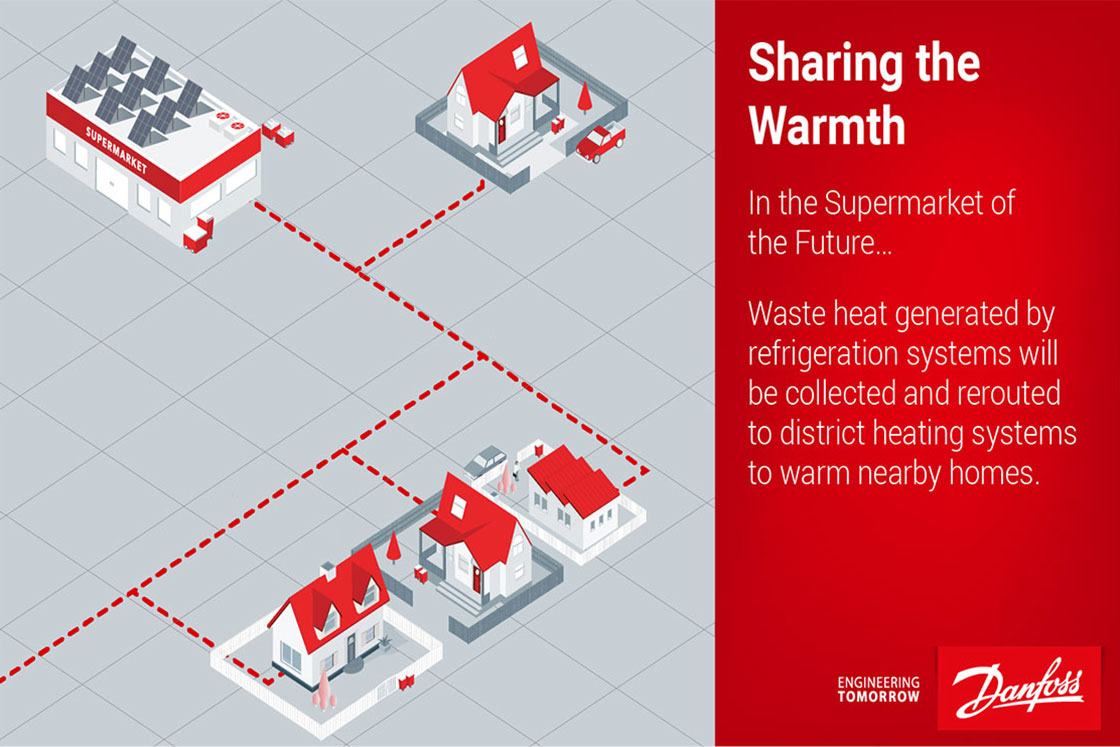
Published: WEF
Imagine visiting the supermarket of the future. You pull into the parking lot and immediately connect your self-driving, electric vehicle (EV) to the available charging station. As you walk through the doors to get ingredients for dinner, you’re bathed in the pleasant light of energy-efficient LED bulbs powered by the store’s rooftop solar panels.
You stroll into the produce section accompanied by your self-driving shopping cart to find the carrots you need for your salad and feel the cool air from the nearby refrigeration unit that’s keeping the groceries fresh. A digital display above the lettuce shows a brief video about how the excess heat produced by the store’s cooling systems is keeping nearby homes warm this winter by connecting the supermarket to the city’s district heating system. While this experience probably sounds like it’s a long way off, recent innovations will make it possible sooner than you might think.
Since their inception, supermarkets have served as the centerpiece of many cities around the world, nourishing their citizens and helping them to thrive. Now, new technology is making it possible to transform the supermarket from an energy consumer to an energy producer for both the supermarket itself and the surrounding community. With this new evolution, the role of the supermarket will expand beyond providing groceries and emerge as a central element of the electrified, decentralized and digitized electricity system of the future as presented by the World Economic Forum in its report, The Future of Electricity – New Technologies Transforming the Grid Edge.
Cooling technologies unlock a new energy reality
Starting in the parking lot, lithium-ion batteries will stockpile the excess power generated by other systems in the building. New electric vehicle (EV) chargers will distribute that extra power to customers who want to top up their car’s battery while they shop, which helps overcome the infrastructural limitation that usually comes with public EV chargers, according to the World Economic Forum. The surplus power can also be stored and used to light up the parking lot at night-time.
Anyone who has ever put their hand behind their fridge can easily understand that the cooling procedure produces a significant amount of heat. This heat has until recently been considered an unwanted by-product of the refrigeration process and simply vented into the atmosphere as waste. However, new technology gives supermarkets the ability to capture that heat, store it, and reuse it in their own systems. By connecting the supermarket to the local district heating grid, excess heat from the supermarket can be redistributed to nearby homes and commercial buildings to help cut energy costs.
On the roof, state-of-the-art solar panels will help power all the systems that make the supermarket run — in a more cost-efficient manner than conventional power sources. Energy-efficient cooling equipment lowers the store’s overall energy use. Any surplus power produced by the systems of the store can be sent back out to the grid to power other businesses and homes.
Cloud-based energy management systems will enable the store to optimize its energy use based on factors such as real time energy price fluctuations, external temperature, and grid demand. Every system in the store — such as integrated refrigeration controls, HVAC (heating, ventilation and air conditioning) and lighting — will be linked together and monitored for trends to reveal opportunities for improved efficiency.
The supermarket will provide flexibility to make the city’s energy supply green
The supermarkets of the future will not only provide fresh food and keep families sustained; they will transform the energy grid and enable it to become safer, cleaner and more flexible. They will be a key element of the decentralized energy system of tomorrow and will set a new standard for efficiency by sharing their surplus energy with their neighbors, reducing energy costs and providing a backup power source. Supermarkets of the future can be based on new business models to mirror a new energy reality that includes integrating excess heat into a supermarket’s portfolio, in addition to groceries.
Energy storage, which combines existing technologies in new innovative ways, must be a focus for policy-makers and city mayors alike. We’re seeing this energy transition take place now in supermarkets and will continue to see the trend grow as we think more creatively.
The opportunities ahead are enormous and supermarkets are blazing the trail toward exciting transformations. By integrating cutting-edge technology, supermarkets will move toward the center of their communities and provide both the food and energy needed for sustainable future growth.

Engineering the world of Tomorrow
Danfoss engineers advanced technologies that enable us to build a better, smarter and more efficient tomorrow. In the world’s growing cities, we ensure the supply of fresh food and optimal comfort in our homes and offices, while meeting the need for energy efficient infrastructure, connected systems and integrated renewable energy.
Our solutions are used in areas such as refrigeration, air conditioning, heating, motor control and mobile machinery.
Our innovative engineering dates back to 1933 and today Danfoss holds market-leading positions, employing more than 26,000 and serving customers in more than 100 countries. We are privately held by the founding family.
